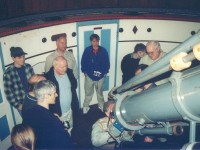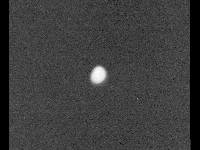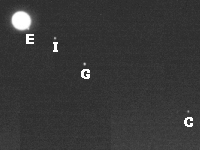 Discussion at the eyepiece of the Tomline Refractor during the astro-photography session.
Discussion at the eyepiece of the Tomline Refractor during the astro-photography session.
Orwell Astronomical Society (Ipswich)
Astro-Photography Practical Sessions
Neil Morley's introductory talk on astrophotography on 12 April 2000 stimulated several members of OASI to "have a go". We therefore organised an astrophotography practical evening on Monday 08 May in the Observatory. On the night the sky was reasonably clear and, by cunning plan, the Moon was near first quarter and presented a good, easy object for beginners to find and photograph. About a dozen people attended. Martin Cook kindly acted as Observing Director for the night and other experienced members assisted.
Martin explained the two basic astrophotography techniques that we could try using the Tomline Refractor:
First we tried the prime focus method. For this there is a coupling ring that screws into the eyepiece barrel of the Tomline Refractor with a 42 mm thread to fit a Pentax, Zenit or similar Single Lens Reflex (SLR) camera body. OASI has two Zenit bodies available for use by members, and there is also a 42 mm to Olympus adapter available. As members found, the tricky bit is to thread your camera onto the mount without dropping it!
In prime focus mode, the telescope objective acts as the lens for the camera, with a focal length of 3.7 m, f/15. A well-known formula gives the diameter of the Moon's image on film using the prime focus method as the focal length of the lens in millimetres divided by 110 - and so it proved, the Moon just filling the width of the film with top and bottom clipped (35 mm film images are 24x36 mm). By loosening the butterfly nut clamping the eyepiece barrel, the camera body could be rotated to frame the Moon nicely or to position the camera controls on top rather than underneath (or both, if you were lucky!) Focussing was the most difficult aspect, since this had to be done through the normal SLR viewfinder, with its ground glass and split prism focussing screen. These are designed for use in high light levels and achieving critical focus was very much a matter of driving in and out of either side of focus, and judging the mid-point.
Monica Lustig had constructed a very useful exposure calculator that Neil had described in his talk. It consisted of three cardboard circles and enabled one to dial in the Moon's phase, film speed and lens f-number and read out the recommended exposure time. Bracketing this by one or two "stops" (factors of two in exposure time) generally ensured at least one well-exposed shot. Several people duly attached cameras to the telescope and took images with exposures ranging from 1/60 second to over a second.
We then tried eyepiece projection. For this method a slightly different coupling ring is used which holds a standard eyepiece in the middle, surrounded by a set of standard 42 mm camera lens extension tubes to which the camera body is attached. Focus is achieved with the telescope focus rack mechanism. Achieving critical focus proved very difficult. Also, the increased magnification of the optical configuration revealed the slight unevenness of the telescope Right Ascension drive and the increasing atmospheric image disturbance. Coupled with the longer exposures required due to the increased magnification and hence reduced f number, it was evident that achieving a sharp final image was going to involve a good measure of luck.
As well as using the telescope optics, one member used a bracket to attach his camera to the objective end of the telescope, using the latter simply as a drive. However, there were problems aligning the optical axis of the camera to that of the telescope and operating the camera is it was swung high up to point at the Moon was not easy.
Later in the evening we switched attention from traditional photographic methods to video techniques. OASI possesses a low-light video camera which can be used in conjunction with a standard television monitor to display images. The camera is in fact designed for surveillance rather than for astronomical use and in particular does not support the long exposure times required to capture faint astronomical objects. Rather it is like a TV camera with fixed exposure time. However, it generally works well with bright astronomical objects such as the moon or planets and can record stars as faint as magnitude 9 (approx).
OASI aims to manufacture a bracket enabling the camera to be fixed rigidly to the Tomline Refractor - however, said bracket does not yet exist and thus it was that society chairman David Payne found himself doing sterling work holding the camera firmly to the telescope eyepiece! Optically, we used the eyepiece projection method; this gave an effective overall image scale whereby some 10° of the lunar limb filled the monitor. This scale gave a pleasing view of the lunar surface, particularly of craters on the terminator.
By coincidence, at this time a lunar occultation took place of the star ZC1150, with the graze track running through East Anglia via Haverhill and Colchester. From Orwell Park the event appeared as a brief total occultation with the south polar regions of the Moon passing in front of the star for some eight minutes. ZC1150 is a magnitude 6.7 star and thus well within range of the video camera. With David Payne still doing magnificent work holding the camera rigidly to the telescope, we observed the disappearance and reappearance of ZC1150. The disappearance occurred on the dark limb, and we saw on the TV monitor the star wink out sharply. Because the geometry of event was very close to a graze there was a considerable discrepancy between predicted and observed event times as follows:
predicted 21:30:36 UT, observed 21:30:24 UT.
In most cases predicted and observed occultation event times differ by no more than 2-3 seconds, so a discrepancy of 12 seconds points up the difficulty of accurately predicting the time of events that are close to grazes!
The reappearance event occurred on the bright limb of the Moon and on the monitor the star had to clear a very bright lunar crescent before it could be clearly discerned - this resulted in a major discrepancy of approximately one minute between predicted and observed event times:
predicted 21:37:47 UT, observed 21:38:48 UT.
Although performance of the camera on the bright limb reappearance event was disappointing, performance on the dark limb disappearance was encouraging. This is a technique that the society could use to observe and time occultation events in the future.
Overall, the astrophotography evening was very successful in letting people get some real hands-on experience. Since we had the lights on for most of the exercise, it was also easier to see who was who, and several good side discussions got going, which tends to be more difficult in the usually darkened dome. If there is enough interest (which may depend on how well our first efforts came out!) we could repeat the event with another observing target.
On Wednesday 10 January, Neil Morley led the discussion during a workshop on astrophotography. He explained the main methods for coupling a camera to the Tomline Refractor (prime focus, eyepiece projection and afocal) and then spent the bulk of the workshop displaying photographs and slides taken by members. Due to a slip-up with publicity, few people were aware that the event was taking place and only ten members attended - however, those who did attend found the workshop very interesting and enjoyable and were keen to try some of the techniques for themselves.
So it was that a few days later, on Monday 15 January, several members of OASI participated in a practical follow-up session at the Observatory. Some members used OASI's two Zenit camera bodies (they are of the old fashioned, mechanical variety and are therefore ideal for long exposure astrophotography, with no batteries to run down.) Other members brought a wide variety of SLR cameras, digital cameras and video recorders. OASI has fitting rings to enable attachment of camera bodies to the Tomline Refractor.
At approximately 20:00 UT, at the start of the session, Venus was only some 5° above the western horizon, scintillating strongly and exhibiting bright flashes of colour. There was no time to couple a camera properly to the telescope so we held an SLR camera by hand very close to the eyepiece of the Tomline Refractor (afocal coupling) and took several photographs with a variety of exposure times less than one second. Conditions were thus far from ideal, but nevertheless, we obtained the photograph shown below which clearly exhibits the phase of the planet (52° at the time).
Half an hour or so later, we turned our attention to Jupiter. Europa had just completed a transit of the planet and was emerging at the western limb (emersion at 20:19 UT). The remaining three Galileans were visible, lined up further to the west. We took several photographs of Jupiter. Through trial and error, it proved possible to capture detail on the main cloud tops (the North and South equatorial belts) using the eyepiece projection method, or to capture Jupiter together with the Galilean satellites via the prime focus or afocal methods. In all cases, exposure times up to a few seconds were suitable. However, we were unable to find a combination of configuration and exposure time that captured both detail on the cloud tops and the Galilean satellites. As usual, it proved difficult to focus an SLR on an image much dimmer than the focus screen was designed for - this prompted much inconclusive discussion about whether OASI should purchase a camera with a magnifying eyepiece to make focussing easier.
We also experimented with OASI's low-light video camera attached to the 10 cm finder telescope on the Tomline Refractor. The camera produced images of Jupiter and Saturn some 20 mm across on the video monitor, and the Galilean satellites were easily visible. However, little detail was visible on the planets themselves, apparently due to the camera's AGC circuitry applying too much gain and saturating the output. We observed that when rotating the dome, as the shutter moved across the line of sight of the telescope it acted as an iris reducing the light input to the camera such that a much better exposure was obtained and Jupiter's belts became visible. It appears that we could put the camera to good use for enabling groups of visitors to see the view through the telescope provided that we can arrange a means to stop down the telescope or use a neutral-density filter to reduce the light level.
 Venus by afocal method, in less than ideal conditions!
Venus by afocal method, in less than ideal conditions!
 Jupiter and the four Galilean satellites. Note Europa emerging from the western limb of the planet.
Jupiter and the four Galilean satellites. Note Europa emerging from the western limb of the planet.
James Appleton & Mike Whybray